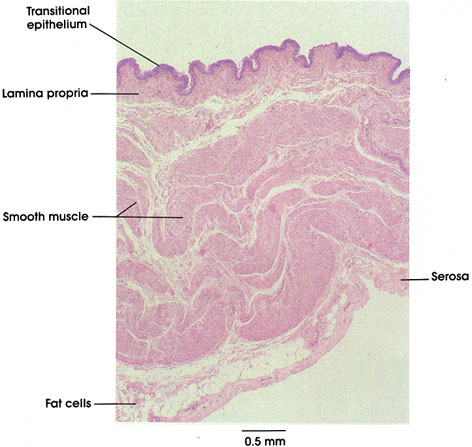

Plate 12.242 Urinary Bladder
Ronald A. Bergman, Ph.D., Adel K. Afifi, M.D., Paul M. Heidger,
Jr., Ph.D.
Peer Review Status: Externally Peer Reviewed

Human, 10% formalin, H. & E., 22 x
The component parts of the wall of the urinary bladder are shown at low power. The innermost layer, the mucosa, consists of transitional epithelium, underlaid by a prominent lamina propria. The folds in the mucosa are seen in three dimension to be extensive longitudinal ridges and represent one means by which the bladder wall accommodates to distention. The thickness of the epithelium is also reduced upon stretching, as is the height of the luminal epithelial cells (dome, or umbrella cells, see Plate 24 for details of the epithelium). Thus, the overall topography of sections of the bladder will always depend upon the state of distention and turgidity of the organ at the time of fixation. The muscular layer of the bladder is generally recognized as consisting of three layers: (1) inner longitudinal, (2) middle circular or spiral; and (3) outer longitudinal. The definition of these as discrete layers is rendered difficult by the intertwining of muscle bundles and fascicles from adjacent layers, and by variation in the thickness of the respective layers in different parts of the organ (e.g., the formation of the internal sphincter by the internal longitudinal layer in the region of the trigone). This histological feature is in contradistinction to the well-defined muscle layers evident in preparations of the gastrointestinal tract. Such a muscular arrangement does, however, facilitate the occlusion of the bladder lumen upon voiding, and the avoidance of residual urine in the bladder, which is recognized as predisposing to bladder infections. The organ is covered by a connective tissue adventitia, except on its superior aspect, which bears a serosa of reflected peritoneum. Present within this layer are blood vessels, nerves, and underlying adipose tissue.
Next Page | Previous Page | Section Top | Title Page
Please send us comments by filling out our Comment Form.
All contents copyright © 1995-2025 the Author(s) and Michael P. D'Alessandro, M.D. All rights reserved.
"Anatomy Atlases", the Anatomy Atlases logo, and "A digital library of anatomy information" are all Trademarks of Michael P. D'Alessandro, M.D.
Anatomy Atlases is funded in whole by Michael P. D'Alessandro, M.D. Advertising is not accepted.
Your personal information remains confidential and is not sold, leased, or given to any third party be they reliable or not.
The information contained in Anatomy Atlases is not a substitute for the medical care and advice of your physician. There may be variations in treatment that your physician may recommend based on individual facts and circumstances.
URL: http://www.anatomyatlases.org/